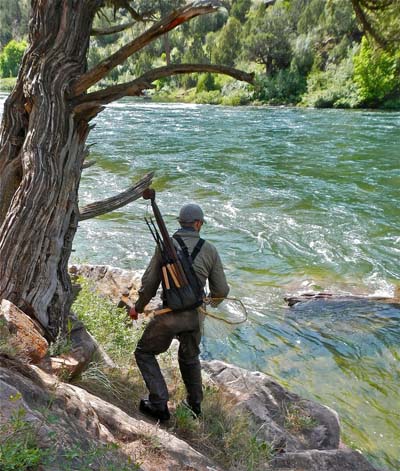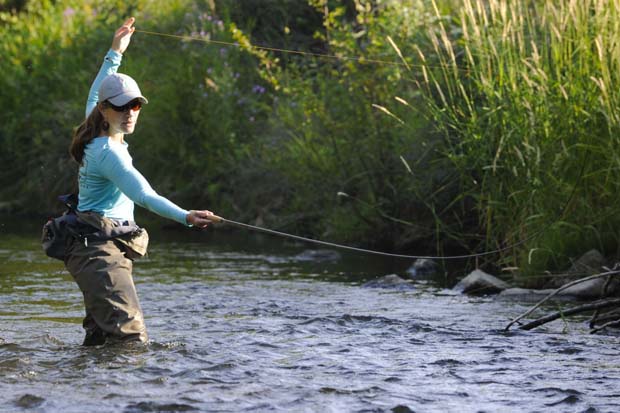The Tenkara method of fly fishing has reached raging enthusiasm
[dropcap]T[/dropcap]he big question for the Tenkara industry, if it can at this point be called such, is the creeping criticism of fly rod performance guidelines. Several standards of performance have been addressed by individuals, by manufacturers, and by sellers. Following is a synopsis of one that showed up in our inbox.
NOTE: We have abbreviated the coverage provided by the source, Discover Tenkara (DT), as its coverage is quite long. You can read the entire performance guidelines as set by DT here . . .
The short version of the ten things. Interestingly, and oddly, a lot of the performance issues addressed by Discover Tenkara about those rods are not addressed by the current fly fishing industry – overhand casting fly rods and two-handed fly rods?

Fly fishing guide with Tenkara gear checks out high flow on mountain stream out West. Image credit Tenkara Guides LLC.
Simple Linear Recovery (lack of wobble)
Extend your rod without a casting line attached. Now make a short overhead casting motion. The casting arc should be around 15 to 20 degrees and should finish with a definite “stop” on the forward cast. As you make this stop, you should soften your grip ever so slightly to allow the rod to recover. Ideally, you should be able to make the rod do “one bounce easily” and then come back to being straight with no persistent wobble. The harder you need to work to do this, the worse the recovery. In the worst rods, you will find it impossible to stop it wobbling.
Rotational Recovery
Again, with the rod extended and with no line attached, hold the rod out in front of you, parallel to the ground. Now “draw” a rapid series of small circles in the air with the rod tip. Think of this like a high speed skipping rope! Abruptly stop the motion and notice how long it takes for the rod to stop moving. Notice also where the rod recovers first and how long it takes for the rest of the rod to “catch up.” . . .
Over Recovery: The Surprising Fault with Some of the Best-Selling Tenkara Rods in the World
Square cut on butt-end of sections Now unscrews the cap on the butt of the rod handle. In turn, carefully reverse out each section by a short distance. Look at how close to 90-degrees the cut face of each section is. Each cut should be as close to square as possible – and not cut at an angle like a slice of French bread. . . .
“Walk-around Test” For Carbon Cloth Density and Construction
. . . Because Tenkara rods have no line guides/rod rings – they should not have a “spine.” All sections can be fitted together without “lining them up” rotationally. They will, therefore, be cast and bent in all directions during use. It is important that they are equally strong when bent in any plane. Many manufacturers have the idea that “big fish” rods should have fast, tip actions. This seems to convince the angler that they can “bully” the big fish. In fact, this works great for fish up to a certain size . . .
The Surprising Pitfall That Rod Designers Can Make
Well, if each joint doesn’t have enough of the next (narrower) section of blank overlapping inside it – then the rod will be in danger of failing unexpectedly. Here is how you need to check it. • Reverse each section of the rod out from the back of the handle and lay each piece on a soft surface where they won’t roll onto the floor. • Taking each section in turn (starting with the first section after the handle) – reverse the section and gently slide into the next section down until it is just snug. This shows how much of the blank remains inside the previous section when it is extended during fishing use. There needs to be enough of the blank in contact with the inside of the previous section to provide strength – and to avoid developing a weak spot by forming a “hinge” that bends and fatigues the blank; normally somewhere around two finger – widths . . .
For slideshow and images click here . . .
To stay tuned and get ahead of the Tenkara curve click here for more information about the Tenkara Jam – fly fishing show in Cherokee, North Carolina this October.
NOTE: Featured Image is Tenkara at its artful best Image courtesy of the Independent Record, Helena, Montana.


